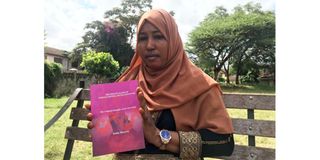My mother took me for FGM out of pressure, not love

Sadia Hussein, a survivor of Female Genital Mutilation with a book she has written The hidden Scars of FGM. She underwent the cut at the age of 10, but now fights to protect girls against it.
What you need to know:
- When Sadia Hussein was 10 years old, she was thrilled to undergo a procedure that is illegal in Kenya - FGM.
- The painful experience left her with lifelong scars, which eventually gave her the voice to fight against the practice.
When Sadia Hussein was 10 years old, she was thrilled, like most girls in her community, to undergo a procedure that is illegal in Kenya and viewed negatively around the world.
“It was a procedure that every girl would want to go through then,” she says of female genital mutilation (FGM).
The painful experience left her with lifelong scars, which eventually gave her the voice to fight against the practice.
“Later on, knowing the complications that follow, based on my personal story and experience, I decided to say no to FGM.”
Peer and community pressure plays a significant role in pushing girls to undergo the procedure, she says.
“Before one gets the cut, other girls put pressure on you, insinuating that you are not clean and some would say you are not a real Muslim,” she adds.
“But after the cut, I started asking myself if there is any connection between the pain and bleeding after FGM and being clean.”
Deinfibulation
Ms Hussein underwent type three of FGM, also known as infibulation –which involves total removal of the clitoris and the labia. The edges of the vulva are then stitched together, with only a small opening left for urination and menstruation.
“It took me more than two months to heal, but that was not the end of my agony. When I got married, I had to be reopened (deinfibulation), and after conceiving, the real complications came with delivery. It was painful.”
The practice is now increasingly regarded as a violation of human rights. Ms Hussein is happy that the government is doing more to eradicate FGM.
“If the State is fighting for (girls’) rights, they would not be lured into being part of harmful cultural practices that cause pain,” she says.
On June 21, Director of Public Prosecutions Noordin Haji and campaigners against FGM launched guidelines for investigating and prosecuting perpetrators of the illegal procedure.
“These (guidelines) should be used as a basis for addressing disparities in the investigation and prosecution of FGM cases. It is my hope that successful conviction of FGM cases will ultimately lead to prevention and eradication of FGM,” he said.
Assistant Inspector-General of Police Judy Lamet, who is also in charge of community policing, invited the public to collaborate with the police and expose people still practising these violations.
Safe houses
“If we want this practice to end, the whole idea should be a partnership. If your neighbour is doing it, let us know,” Ms Hussein observes.
Highlighting safety for victims as a challenge, she says police find it hard to get a safe house that readily accepts the girls, especially now during the Covid-19 pandemic as there are no government-owned safe houses.
Bernadette Loloju, CEO of the Anti-FGM Board, urges stakeholders to be actively involved in eradicating the practice.
“There are grey areas such as poor reporting of cases because of the involvement of family members and sometimes, poor gathering and preservation of evidence by the police,” she says.
“The launch of the (guidelines) should henceforth, allow seamless cooperation between the chiefs, police and the community.”
Dr Samuel Kimani, a researcher at the Africa Coordinating Centre for Abandonment of Female Genital Mutilation at the University of Nairobi, says FGM has changed in how it is practised.
“We have to let the (guidelines) be live because FGM is mutating. For instance, now, there is rampant medicalization of the cut by trained doctors,” he says.
Harmful practice
“Its severity in terms of the depth of the cut as well as the age for mutilation, has also changed. These days, young girls aged three undergo FGM, and it is no longer a rite of passage as it were.”
DPP Haji also stressed the need to do away with the medicalization of the harmful practice.
The guidelines were launched three months after the High Court upheld the ban on the female cut.
Dr Tatu Kamau had, in 2017, sued seeking to decriminalise FGM. Kenya outlawed the practice in the Female Genital Mutilation Act of 2011.
Ms Hussein tells nation.africa that she was one of the witnesses who testified against decriminalising the practice.
“When I testified about my experience in court, Dr Tatu was even consoling me, telling me that she was sorry and that she was sure my mother did that out of love,” she says.
“I told her my mother did it out of pressure, community pressure – not because of love.”
“My mother did not have a voice then, but I’m glad I now have a voice and I will protect my children,” she adds.
The 2019 Demographic Health Survey indicated that FGM prevalence in Kenya is about 21 per cent.





